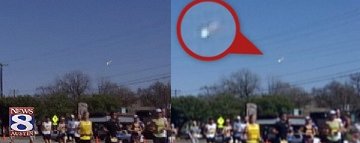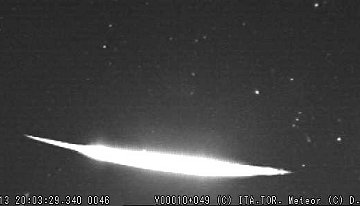 |

|
FIREBALL MANIA: (Feb. 16, 2009) Runners in the 2009 Austin marathon were astonished when a brilliant fireball raced across the Texas sky in broad daylight. The extremely-bright meteor descended at 11 am CST on Feb. 15th less than a day after the FAA reportedly warned U.S. pilots to watch for "falling space debris" from the recent satellite collision between Iridium 33 and Kosmos 2251. Click on the image to launch a News 8 Austin video: What you just saw was not satellite debris. The high speed of the fireball in the News 8 video is typical of a natural meteoroid hitting Earth's atmosphere at tens of km/s. Orbital debris, on the other hand, should crawl across the sky at a fraction of that speed. Astronomer Bill Cooke of NASA's Meteoroid Environment Office has reviewed the video and confirms "it's a natural meteor, definitely." According to his analysis, the source of the fireball was a meter-class asteroid traveling at about 20 km/s. Fireball mania started on Friday the 13th, around 10 p.m. EST, when people in central Kentucky heard loud booms, felt their houses shake, and saw a fireball streaking through the sky: reports. "The world appeared to explode--in green!" said one eyewitness. Once again, this appears to be a natural event caused by a meteoroid. Iridium 33 and Kosmos 2251 collided at a speed of about 10 km/s or 22,000 mph. None of the surviving fragments should have been big enough to shake houses in Kentucky. Furthermore, US Space Command, which monitors objects in Earth orbit, has not announced a reentry over Kentucky on Feb. 13th. Just hours before the Kentucky event, around 20:03 UT on Feb. 13th, multiple cameras in Italy recorded a fireball some 10 times brighter than a full Moon. Astronomer Diego Valeri sends this image from the town of Rieti:
Ferruccio Zanotti of Ferrara, Italy, recorded that same fireball and two others. Italian scientists are plotting the trajectory of the brightest fireball to estimate where it might have hit the ground; a meteorite hunt will soon be underway. Although it is tempting to attribute the Kentucky and Italian fireballs to debris from the Feb. 10th collision of the Iridium 33 and Kosmos 2251 satellites, they seem to be meteoroids, not manmade objects. Are we experiencing a "fireball shower?" Not necessarily. Meteoroids hit Earth every day. The daily fireballs they produce, however, are seldom reported: 70% streak over uninhabited ocean; half appear in glaring daylight; many are missed because people are asleep, at work, or not looking up. This current spate of fireballs could simply be a few ordinary, random meteoroids that have attracted extraordinary attention because of the recent satellite collision. The jury is still out. Stay tuned for updates. ©2009 Spaceweather.com.
All rights reserved.
|
|

